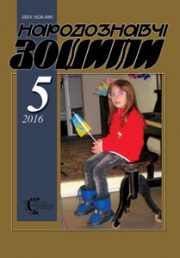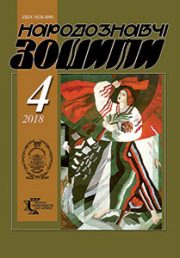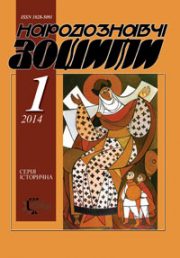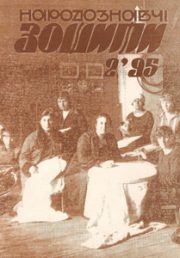The Ethnology Notebooks. 2021. № 4 (160), 886—892
UDK398.41(=1:477.82-021.181)
DOI https://doi.org/10.15407/nz2021.04.886
«BLUD» IN THE DEMONOLOGICAL IDEAS AND BELIEFS OF THE PEOPLE OF VOLHYNIA
KRYVENKO Anastasiia
- ORCID ID: https://orcid.org/0000-0001-9353-2919
- Candidate of Sciences in History,
- Senior Researcher,
- the Institute of Ethnology
- of the National Academy of Sciences of Ukraine,
- The Department of Modern Ethnology,
- 15, Svobody Avenue, 79000, Lviv, Ukraine,
- Contacts: е-mail: n.d.kryvenko@gmail.com
Abstract. According to the materials of field research of the author in the article it is analyzed the demonological representations of Volynians about Blud. The study area covers ethnographic Volhynia with a well-preserved existence of archaic ideas, which, however, are insufficiently covered in the ethnographic literature. The introductioninto scientific circulation and analysis of field materials collected by the author on the territory of ethnographic Volhynia is the scientifically significant and actual task. The object of the research is Blud as the demonological character in the mithological ideas of the people of Volhynia. The subject— characteristics of the people of Volhynia ideas about its appearance, function, location, genesis, as well as magical and ritual methods of ptotection from it and its neutralization. The purpose of the study is a comprehensive description of traditional demonological notions of the «Blud», represented in the beliefs, customs and rituals of Volhynia. The chronology of the study covers the period from the middle of the XIX century to the modern period of the studied phenomena. The article is based on methodological approaches to the complex historical and ethnological study of ethnocultural phenomena and covers the application of various methods (field observation, typological analysis, structural-functional, comparative-historical, reconstructive, structural-semantic). The source basis of the study is the ethnographic materials collected during historical and ethnographic expeditions by the author during 2009—2019. It was found that the Blud is one of the most common images in the traditional demonological ideas of the people of Volhynia, which today in many stories and tales is identified with the image of the devil. Archaic features, specific local features of Volhynia beliefs about fornication, as well as in some preventive and apotropaic ways to prevent and neutralize its harmful effects have been identified.
Keywords: ethnographic Volhynia, Blud, demonology, ideas, beliefs, apotropaic.
Received 10.08.2021
REFERENCES
- Bulashev, H. (1992). Ukrainian people in their legends, religious views and beliefs. Cosmogonic Ukrainian folk views and beliefs. Kyiv [in Ukrainian].
- Halajchuk, V. (2016). Ukrainian mythology. Kharkiv [in Ukrainian].
- Chebaniuk, O.Y. (2014). Ukrainian folk beliefs and legends about wandering: semantics, pragmatics, functions. Slavic world, 13, 20—32 [in Ukrainian].
- Hnatiuk, V. (2000). Essay of the Ukrainian mythology. Lviv [in Ukrainian].
- Khobzej, N. (2002). Mythology of the Hutsul region: ethnolinguistic dictionary: ethnolinguistic dictionary. Lviv [in Ukrainian].
- Kryvenko, A. (2014). Calendar customs and beliefs of the Volynians. Field materials collected in the villages of Khmilnytsky district of Vinnytsia region, Starokostiantynivsky and Bilogirsk districts of the Khmelnytsky region, Lanovets district of the Ternopil region. Archive of the IN NANU (Archive of the Institute of Ethnology of the National Academy of Sciences of Ukraine). F. 1. Op. 2. Od. save 737. Arc. 1—283 [in Ukrainian].
- Kryvenko, A. (2015). Calendar customs and beliefs of the Volynians. Field materials collected in the villages of Busk and Brody district of the Lviv region. Archive of the IN NANU. F. 1. Op. 2. Od. save 773. Arc. 1—109 [in Ukrainian].
- Kryvenko, A. (2017). Calendar customs and beliefs of the Volynians. Field materials collected in the villages of Zhovkva district of the Lviv region. Archive of the IN NANU. F. 1. Op. 2. Od. save 800. Arc. 1—63 [in Ukrainian].
- Kryvenko, A. (2019). Calendar customs and beliefs of the Volynians. Field materials collected in the villages of Kivertsi and Rozhyshche districts of the Lviv region. Archive of the IN NANU. F. 1. Op. 2. Od. save 826. Arc. 1—20 [in Ukrainian].
- Kryvenko, A. (2019). Calendar customs and beliefs of the Volynians. Field materials collected in the villages of Rivne and Kostopil districts of the Lviv region. Archive of the IN NANU. F. 1. Op. 2. Od. save 827. Arc. 1—28 [in Ukrainian].
- Kryvenko, A. (2009). Field ethnographic materials on the theme «Demonology», recorded by Kryvenko Anastasiia Oleksandrivna on 2009 in Hoshcha district of the Rivne region. Archive of the Ivan Franko LNU. F. R-119. Op. 17. Act. 288-E. Arc. 1—63 [in Ukrainian].
- Kryvenko, A. (2010). Field ethnographic materials on the theme «Demonology», recorded by Kryvenko Anastasiia Oleksandrivna on 2010 in Gorokhovsky district of the Volyn region. Archive of the Ivan Franko LNU. F. R-119. Op. 17. Act. 337-E. Arc. 1—53 [in Ukrainian].
- Kryvenko, A. (2013). Field ethnographic materials on the theme «Calendar layer of Volyn demonology», recorded by Kryvenko Anastasiia Oleksandrivna in July 3—15, 2013 in Chernyakhiv, Chervonoarmijsk, Volodar-Volynsk districts of Zhytomyr region. Archive of the Ivan Franko LNU. F. R-119. Op. 17. Act. 496-E. Arc. 1—122 [in Ukrainian].
- Kryvenko, A. (2013). Field ethnographic materials on the theme «Calendar layer of Volyn demonology», recorded by Kryvenko Anastasiia Oleksandrivna in August 6—11, 2013 in the Sokal district of Lviv region and Ivanychiv district of Volyn region. Archive of the Ivan Franko LNU. F. R-119. Op. 17. Act. 497-E. Arc. 1—80 [in Ukrainian].
- Halajchuk, V., & Solop, B. (2019). Traditional attitudes toward suicides on the territory of historical and ethnographic Volyn. Visnyk of the Lviv University. Historical Series (Pp. 927—951). DOI: http://dx.doi.org/10.30970/his.2019.0.9902 [in Ukrainian].
- Halaichuk, V. (2021). Traditional Demonology of Khmilnyk District. Scientific notes of Vinnytsia State Pedagogical University named after Mykhailo Kotsyubynsky. Series: History, 36, 82—92. Vinnytsia. DOI: https://doi.org/10.31652/2411-2143-2021-36-82-92 [in Ukrainian].
- Kryvenko, A. (2020). Folk demonology of Volhynia: calendar and ritual context. Lviv [in Ukrainian].
- Kopernicki, I. (1887). A contribution to the ethnography of the Rusian people in Volynia from the materials collected by P. Zofia Rokossovska in the village of Jurkowshchyzna in the Zwiahel poviat. Zbior wiadomosci do antropologii krajowej (Vol. 11, pp. 130—228) [in Polish].
- Sokalski, B. (1899). Sokal poviat in the geographic, ethnographic, historical and economic terms. Lwow [in Polish].
- Kravchenko, V. (1928). From the life and ceremonies of the northwestern Ukraine. In Volyn Research Museum (Vol. 1, pp. 67—114). Zhytomyr [in Ukrainian].
- Kravchenko, V. (1920). The customs are in the village of Zabridi and some others who are not far from this village in the areas of Zhytomir district in Volhynia. Ethnographic materials. Zhytomyr [in Ukrainian].
- Boltarovych, Z., & Skrypnyk, H. (1994). Worldviews and beliefs. In Podillya: historical and ethnographic research (Pp. 349—358). Kyiv [in Ukrainian].
- Ilarion, mytrop. (1991). Pre-Christian beliefs of the Ukrainian people: historical and religious monograph. Kyiv [in Ukrainian].
- Halajchuk, V. (1994). Prose folklore of Kyiv Polissya. In Polissya of Ukraine: Materials of historical and ethnographic research (Issue 1, pp. 229—244). Lviv [in Ukrainian].
- Sakharov, Y.P. (1849). Legends of the Russian people, collected by Y.P. Sakharov. Sankt-Peterburh [in Russian].
- Pomerantseva, E.V. (1975). Mythological characters in Russian folklore. Moskva [in Russian].
- Kulda, B.M. (1874). Moravske narodni pohadky, povesti, obyceje a povery. Praha [in Czech].







